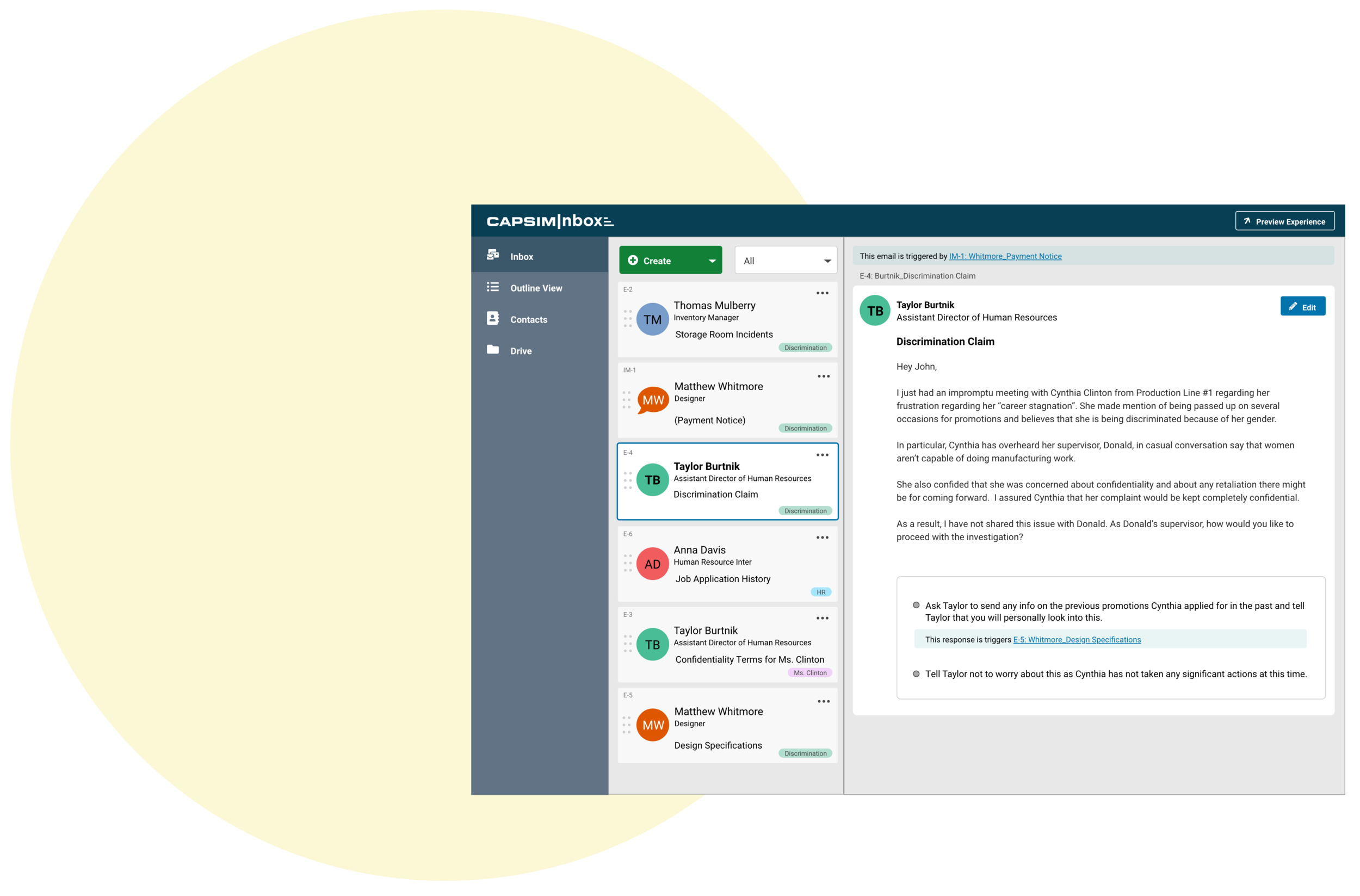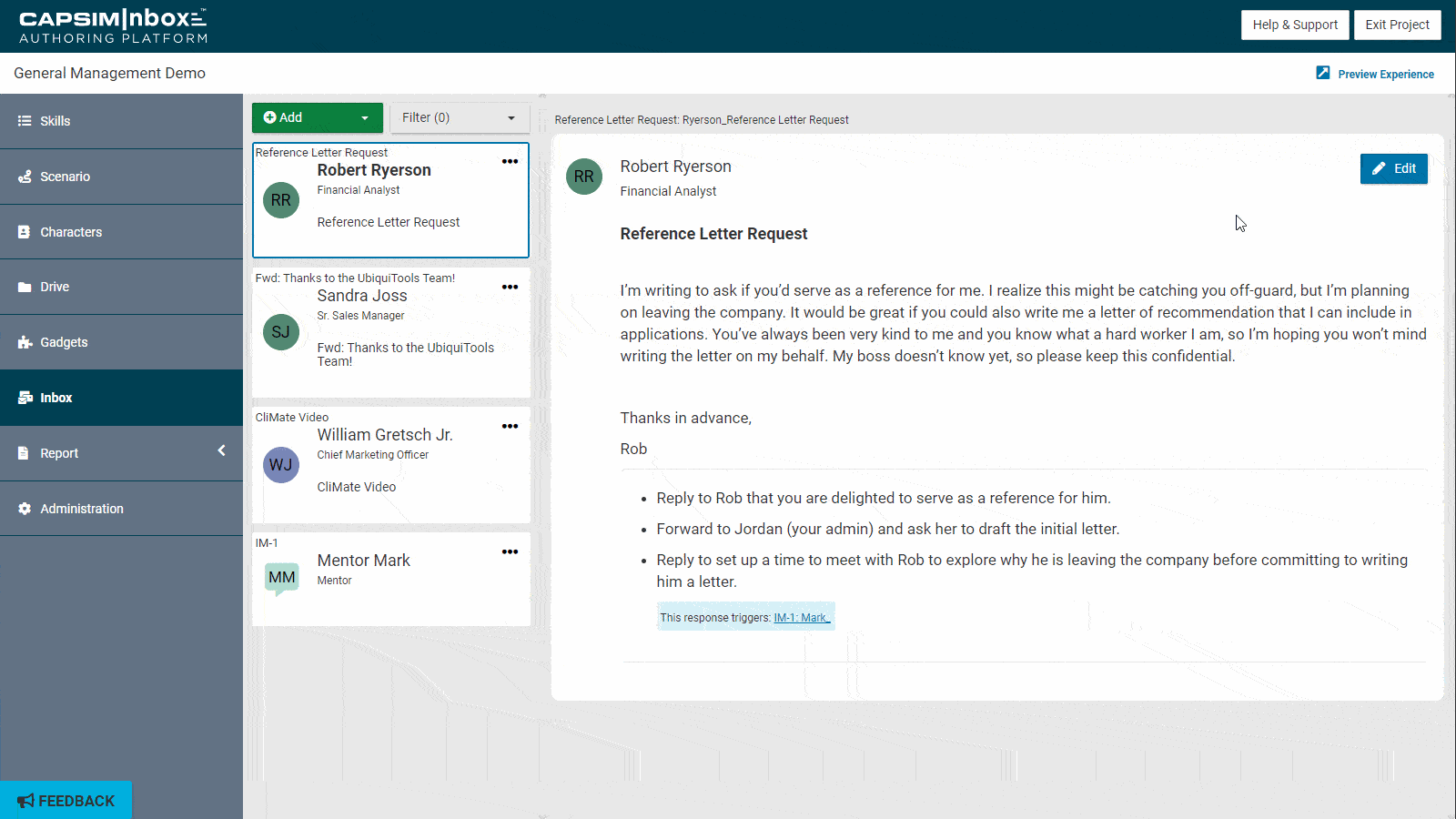Inbox Authoring
Director of Product Design & Development — 2019-2021
The discovery, design, & development of the award-winning workforce training tool, Inbox Authoring Platform.
What if creating a game was as easy as writing an email? We made that a reality for experts authoring learning experiences in Inbox.
Driving Question
How might we bring experiential learning to every part of job training?
The scoop
Role — Director of Product Design & Development, drove strategic vision and led Product team
Team — A team of 8-15 designers, developers, analysts, testers, Product Managers, and Subject Matter Experts.
Goals — Expand our reach into corporate training with a best-in-class game authoring tool. Build a new business line and validate growth via new Inbox launches and corporate adoptions.
Results — 4x EdTech Digest award-winner (2020, 2021, 2022) for Best Corporate Training Solution, Best Professional Skills Solution, Best Hiring Tool, and the Workforce Trendsetter Award (over Salesforce and IBM Watson).
50+ custom training simulations. 10,000+ users at Fortune 500 clients and top universities worldwide. NPS 55.
Skills — Product Vision/Strategy, Product Leadership, Product Discovery, Conceptual Design, UX Design + Research, Interaction Design, Team Leadership, Mentoring Designers, Information Architecture, Go-To-Market Strategy, Market Development, Marketplace Design
Discovering the expert-creator gap
Throughout the launch of Inbox, we built a base of outspoken, ambitious experts. They wanted to tell their own stories, and they loved the idea of experiential learning.
But they had been held back from publishing substantial non-academic content. We uncovered their hesitations in authoring books, making videos, and working with software people (quite the stories to share…).
Early wireframe sketches and workflow details. I like notebooks.
And here, we discovered a trend. During our field study, we found experts were hesitant to create because:
they hadn't found a sensible way to turn their stories into experiences, and
it was hard to connect the dots from different areas of their knowledge.
We call this the expert-creator gap, and we modified our tool to make email writing feel like storytelling. People could create an Inbox simulation, right within their email inbox!
We set out to solve this problem as intuitively as possible. Even after assessing the best authoring and training tools on the market, tools were often only used by Instructional Designers. This was a huge challenge to adoption across a company.
Authoring an Inbox, within an inbox. Write an email, then play through it in real-time.
The design followed as such: If you can write an email, you can write an Inbox.
We built a framework to extract key insights while deidentifying personal information. I wrote about how to author your own Inbox simulation here, and we turned the core elements into an interactive guide to use while building.
Our first season introduced the concept to 20 creators. From it, 12 accepted and authored their first piece, with each Inbox at least a 15-minute edition.
To this day, 7 of those 12 early prototypes have sold thousands of Inbox licenses, while 3 others turned into published versions under a different name.
During this time, we held global competitions with business authors and training consultants. The top 6 competed in GBSN’s First Inbox Competition, and the top offering has been used in business schools worldwide.
We learned that while our onboarding process was improving, a sizeable gap still existed.
Scaling Beyond Champions
We found the hardest part is getting people to begin. In our work, we deduced the traits of top users — their actions, their content, their timelines, and on. We wanted to get an idea of the person who would write this content so we could turn this persona into our target market.
Our findings were incredibly impactful to our market development efforts, which found their way into the initial touchpoint with the Authoring Platform. Once a potential author wrote 3 emails and linked 2 emails together, the likelihood of completion rose by 12x! 3 emails and a link — that’s all it took!
We discovered this through a set of experiments and the fantastic analytics tool, Pendo. Through our analysis, we had set the table for a series of future experiments.
This was our key driver of success, and we set out to solve this problem. Even with the fanfare from our earliest users, we found new customers were getting hung up in the starting blocks. Almost all (~85%) new users would work through the introductory demo and write at least one email, but here we saw a large drop-off. To translate, we needed to focus on onboarding new authors.
My first major design revision was to implement backlinks — a popular feature of nearly all tools for thought today. In 2019, though, we were merely scratching the surface of understanding what the wiki-style backlink could do. By creating a backlink between skills, emails, and responses, authors could rapidly connect the dots between their story. It was like a superpower!
From there, we kicked off three experiments to understand how to move the needle, with our key metrics: time to create, pilot NPS, and adoption.
One of many whiteboard sessions around optimizing the onboarding process to author an Inbox.
Our first approach was a set of templates based on common work situations. In one case for Hiring Managers, an interview candidate ticked all the boxes but showed red flags in recommendations — what to do? In another, a Product Manager had to decide what feature work was essential to growing the user base.
Our second experiment focused on an old Paul Graham trick that we see companies like Stripe use today. Embed the storefront demo in a storefront builder, i.e. lazy registration. When you visited our website, instead of asking you to log in and create an account before playing with the tool, we just let you play with the tool! We saw some benefit here, but it didn’t get at the core issue — people still struggled to start.
The most effective of our experiments was a constructable demo. Within our design team, we worked with business leaders at McDonald’s, SAP, Boeing, Hyatt, and a series of HR consultancies. Their feedback helped us discover this path forward, and their testing of early prototypes resulted in a 5-minute demo that you can try out here.
Following our implementation experiments, we saw completion rates rise by 2x. We were building our revenue stream, but we still needed more.
Building the Market
We had built a base of authors promoting their work in our marketplace, but our next step was to embed ourselves in the corporate L&D world. We walked hundreds of authors through our methods — tying corporate trainers to internal SMEs and giving them a playbook to create great games.
The internal communication style guide I wrote (h/t Webflow!) gave external authors a path towards crafting great games.
Our pitch evolved, too. With our experiment in creators in a B2C market blooming, we moved into the corporate training market. We approached L&D teams with a simple approach: give us an hour of your time, and we'll draft a 5 minute game that shows you who's good at their jobs.
This package deal was formed by myself and our Director of Marketing. We would hold an hour-long call with a small group of Learning Experience Designers and Subject Matter Experts, and craft 3 emails by the end of the call. We would leave them with some homework — find 5 more emails like the ones we wrote, deidentify the people, and link them into a thread.
This resulted in our first two major adoptions across entire corporations — S&P Global (of S&P 500 fame) and The Humane Society of America implemented custom Inboxes. Plenty of others were in conversations, including a major technology brand that has since signed a contract (hint: you’re probably using their OS).
Reflections
I closed my time at Capsim at this time, deciding to move on after a decade building impactful software for learners and creators. As I left, we were building a more scalable and personalized onboarding that was performing at exceptional success rates.
There were many loud clients who wanted a more streamlined interface, so we set out to redesign this through the principles of simplicity, clarity, and positivity — and make the experience fully accessible based on WCAG 3.0 Guidelines.
Here, I led a Product Manager, Sr. UI Designer, and Sr. UX Designer through a 3-month parallel exploration. Our theme’s redesign used a modernized Material Design framework with React used for enhanced interactions.
While the wealth of changes lies in the interactions, three primary changes can be seen:
Simplicity — Our initial design used Bootstrap 3, which helped us release quickly, but missed in comparison to known email tools. Our redesign used Microsoft Outlook as a base, as user satisfaction of its interface was highest in the industry.
Clarity — We gave authors the ability to provide feedback in real-time, with IMs and notifications acting as delivery mechanisms. Also added was a custom onboarding experience for authors in order to match their specific role.
Positivity — A complaint against the initial interface was its dim design. We lightened the interface and decided to implement a brighter color scheme and font choice throughout.
Redesigning the user interface with a focus on clean, streamlined design based on extensive user survey feedback.
Our reports received a major upgrade, as well, as seen in the image below. Our focus was to upgrade the interaction between learner and feedback. We found progression to Individual Development Plans was lower than HR managers had hoped.
Our refined (left) report design evolved from its humble roots (right), based on key feedback from learners and HR managers.
The time building Inbox and the Inbox Authoring Platform led me into my research on tools for thought, and, more broadly, human interaction with technology. Before I left, I wrote about Inbox becoming a new tool for thought, which acted as a nice springboard for my research.
As I watch the progress from afar, I’ve seen the Inbox Authoring Platform continue to win key awards, including the 2022 EdTech Digest Best Workforce Development Tool. Best of all, the tool keeps getting better. That makes me a happy parent.




